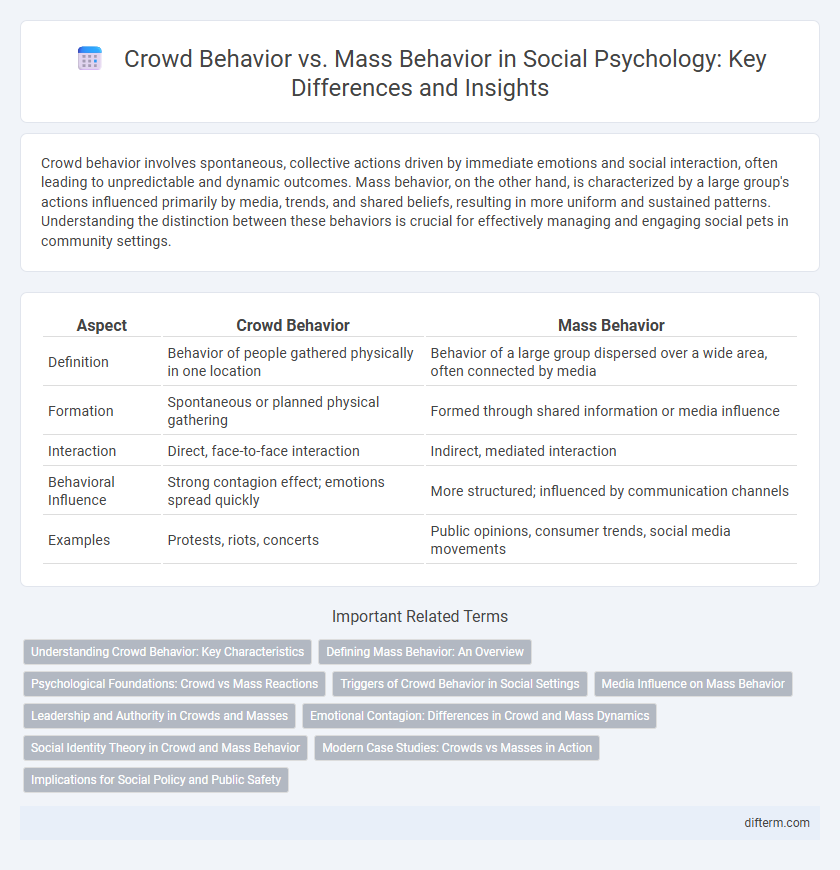Crowd behavior involves spontaneous, collective actions driven by immediate emotions and social interaction, often leading to unpredictable and dynamic outcomes. Mass behavior, on the other hand, is characterized by a large group's actions influenced primarily by media, trends, and shared beliefs, resulting in more uniform and sustained patterns. Understanding the distinction between these behaviors is crucial for effectively managing and engaging social pets in community settings.
Table of Comparison
| Aspect | Crowd Behavior | Mass Behavior |
|---|---|---|
| Definition | Behavior of people gathered physically in one location | Behavior of a large group dispersed over a wide area, often connected by media |
| Formation | Spontaneous or planned physical gathering | Formed through shared information or media influence |
| Interaction | Direct, face-to-face interaction | Indirect, mediated interaction |
| Behavioral Influence | Strong contagion effect; emotions spread quickly | More structured; influenced by communication channels |
| Examples | Protests, riots, concerts | Public opinions, consumer trends, social media movements |
Understanding Crowd Behavior: Key Characteristics
Crowd behavior is characterized by high emotional intensity, temporary group formation, and focused interaction, often leading to spontaneous and unpredictable actions. Unlike mass behavior, which is more diffuse and dispersed, crowds share a physical presence and immediate social influence that amplify collective behavior. Key features include anonymity, suggestibility, and contagion, which drive rapid shifts in mood and decision-making within the crowd context.
Defining Mass Behavior: An Overview
Mass behavior refers to the collective actions and responses of large groups of people who may not have direct interaction but are influenced by common stimuli, such as media or societal events. Unlike crowd behavior, which involves face-to-face interaction and emotional contagion among individuals in close proximity, mass behavior often occurs through indirect communication channels and influences social norms on a broader scale. This phenomenon includes patterns like public opinion shifts, panics, and social movements driven by collective perceptions rather than immediate personal connections.
Psychological Foundations: Crowd vs Mass Reactions
Crowd behavior emerges from direct, face-to-face interactions where individuals experience heightened emotional contagion and deindividuation, leading to impulsive, spontaneous actions. Mass behavior involves dispersed individuals connected through media or symbols, with reactions shaped by shared social identities and cognitive framing rather than immediate social influence. Psychological foundations highlight that crowd reactions are driven by collective emotions and anonymity, while mass responses rely on mediated communication and interpretative processes.
Triggers of Crowd Behavior in Social Settings
Crowd behavior is often triggered by emotional contagion, where individuals rapidly adopt the feelings and actions of those around them, leading to spontaneous collective responses. External stimuli such as provocative events, shared goals, or perceived threats amplify this effect, creating a heightened state of arousal that influences group dynamics. Unlike mass behavior, which is spread through media and less immediate interaction, crowd behavior relies heavily on face-to-face contact and the physical presence of others to activate these psychological triggers.
Media Influence on Mass Behavior
Mass behavior is significantly shaped by media influence, as mass communication channels disseminate information rapidly, creating a unified response among large populations. Media frames events and issues in ways that can amplify emotions, shape public perceptions, and direct collective actions, often leading to predictable patterns in mass behavior. Unlike crowd behavior, which emerges spontaneously in localized settings, mass behavior involves widespread, mediated exposure that synchronizes the attitudes and responses of diverse individuals across geographic boundaries.
Leadership and Authority in Crowds and Masses
Leadership in crowds often emerges organically through shared goals and decentralized influence, whereas mass behavior typically requires formal authority and structured leadership to coordinate actions. Crowds exhibit spontaneous, fluid dynamics where leaders gain legitimacy through consensus and emotional connection, contrasting with masses that rely on hierarchical commands backed by institutional power. Authority in masses enforces order and compliance, while leadership in crowds thrives on mutual identification and collective identity.
Emotional Contagion: Differences in Crowd and Mass Dynamics
Emotional contagion in crowd behavior results in rapid, face-to-face transmission of feelings, creating a unified emotional atmosphere through direct interaction and nonverbal cues. In contrast, mass behavior involves dispersed individuals influenced by mediated communication, leading to slower and less synchronized emotional responses. The immediacy and proximity in crowds amplify emotional intensity, whereas mass dynamics depend on information channels that shape collective moods more diffusely.
Social Identity Theory in Crowd and Mass Behavior
Social Identity Theory explains that crowd behavior emerges when individuals perceive themselves as part of a unified group, which intensifies shared norms and collective emotions. Mass behavior, however, involves a larger, more impersonal audience where social identity is less pronounced, leading to less cohesive group dynamics. Understanding the distinction between crowd and mass behavior through this theory highlights how group identity influences conformity, motivation, and collective action.
Modern Case Studies: Crowds vs Masses in Action
Modern case studies reveal distinct differences between crowd behavior and mass behavior, highlighting how crowds often exhibit spontaneous, emotionally charged actions in events like protests or flash mobs, while masses demonstrate more structured, influenced behavior seen in social media-driven movements or large-scale voting patterns. Crowds tend to form physical proximity and show contagious emotions, whereas masses are dispersed and influenced by media narratives and opinion leaders. Understanding these dynamics helps in managing public safety and designing effective communication strategies during social upheavals and political campaigns.
Implications for Social Policy and Public Safety
Understanding the distinctions between crowd behavior and mass behavior is crucial for developing effective social policies and enhancing public safety measures. Crowd behavior, characterized by intense emotional contagion and close physical proximity, often requires targeted crowd control strategies such as real-time monitoring and rapid response protocols. In contrast, mass behavior, which occurs over dispersed populations influenced by media and social networks, necessitates broader communication policies and public awareness campaigns to mitigate misinformation and prevent panic.
crowd behavior vs mass behavior Infographic

 difterm.com
difterm.com